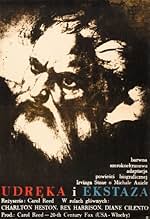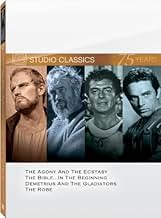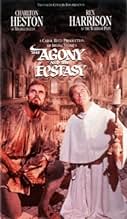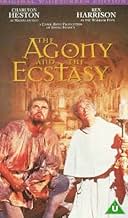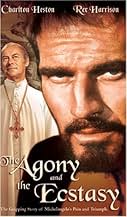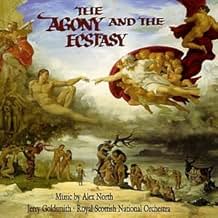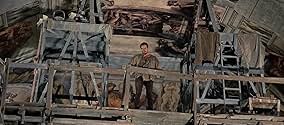Michelangelo - Inferno und Ekstase
Originaltitel: The Agony and the Ecstasy
IMDb-BEWERTUNG
7,2/10
8578
IHRE BEWERTUNG
Die biografische Geschichte von Michelangelos Schwierigkeiten bei der Ausmalung der Sixtinischen Kapelle auf Drängen von Papst Julius II.Die biografische Geschichte von Michelangelos Schwierigkeiten bei der Ausmalung der Sixtinischen Kapelle auf Drängen von Papst Julius II.Die biografische Geschichte von Michelangelos Schwierigkeiten bei der Ausmalung der Sixtinischen Kapelle auf Drängen von Papst Julius II.
- Regie
- Drehbuch
- Hauptbesetzung
- Für 5 Oscars nominiert
- 3 Gewinne & 9 Nominierungen insgesamt
Fortunato Arena
- Pope's Bodyguard
- (Nicht genannt)
Lars Bloch
- Baron Von Silenen
- (Nicht genannt)
Angelo Boscariol
- Papal Guard
- (Nicht genannt)
Calisto Calisti
- Physician
- (Nicht genannt)
Amerigo Castrighella
- Quarry cart assistant
- (Nicht genannt)
Anita Ceccotti
- Woman Under the Chapel
- (Nicht genannt)
Enrico Chiappafreddo
- Tavern Customer
- (Nicht genannt)
Empfohlene Bewertungen
The picture deals with Michelangelo or Michael Angel (Charlton Heston) who is working on the Carrara's marble creating sculptures and he is then ordered by Pope Julius II (Rex Harrison) the painting of as called Sistine chapel (that's why it was built by Pope Sisto) . Meanwhile , they'll develop various relationships with other Renaissance's important people . The film is correctly based on historical deeds and appearing famous roles , such as : Raphael (Tomas Milian) who shows up painting the ¨Athenas' school¨, Bramante (Harry Andrews) builder of the Vatican dome that hold his name , Girlandaio , Florence Medicis' descendants (Diane Cilento and Adolfo Celi) and duke of Urbin (Alberto Lupo). Besides , the film paces itself the confrontation between Julius II troops and the French/German army for the possession of the Pope's states . There are epic and impressive battles where the Pope himself fights enemies . The motion picture describes specially the creation of the enormous paintings on the ceiling and the difficulties that Michael Angel is suffering to achieve the immortal legacy . The Pope Julio II will also assign him the realization of his tomb .
The feature movie obtained a limited success and had a moderated box-office ; however , being nowadays better valued than the past . First-range acting by the two main actors : Charlton Heston and Rex Harrison , both of whom are magnificent . However , Rex Harrison did not get along with Charlton Heston at all during shooting ; in fact , twelve years later, while filming as secondary actors ¨Crossed swords¨ (1977) directed by Richard Fleischer , Rex avoided him utterly . Leon Shamroy's cinematography is rousing , the colorful paintings are glowing and brilliant ; spectacularly showing Bible's scenes at the Sistine Chapel . Alex North musical score is riveting (like ¨Spartacus¨ who he equally composed) . The sets are overwhelming and breathtaking , they were stunningly designed by production designer John De Cuir . In addition , evocative as well as adequate costumes by Oscarized Vittorio Nino Novarese . Carol Reed production and direction were excellent , he'd got much experience through a long career and had directed other classic movies (The third man) . Rating: Very good , above average and well worth seeing.
The feature movie obtained a limited success and had a moderated box-office ; however , being nowadays better valued than the past . First-range acting by the two main actors : Charlton Heston and Rex Harrison , both of whom are magnificent . However , Rex Harrison did not get along with Charlton Heston at all during shooting ; in fact , twelve years later, while filming as secondary actors ¨Crossed swords¨ (1977) directed by Richard Fleischer , Rex avoided him utterly . Leon Shamroy's cinematography is rousing , the colorful paintings are glowing and brilliant ; spectacularly showing Bible's scenes at the Sistine Chapel . Alex North musical score is riveting (like ¨Spartacus¨ who he equally composed) . The sets are overwhelming and breathtaking , they were stunningly designed by production designer John De Cuir . In addition , evocative as well as adequate costumes by Oscarized Vittorio Nino Novarese . Carol Reed production and direction were excellent , he'd got much experience through a long career and had directed other classic movies (The third man) . Rating: Very good , above average and well worth seeing.
The Agony and the Ecstasy is the story of the creation of the Sistine Chapel Roof painting, the time and money it took while Pope Julius II was busy establishing his Papacy as a political force.
Back in those days the Pope was far more than the head of the Roman Catholic Church. He ruled a considerable piece of real estate in the center of the Italian peninsula that were called the Papal States. They varied in geographic size depending on how relatively strong the Pope or his enemies were at a given time. The Papal States were the last independent entity to join a united Italy in 1870.
The Borgias had been nibbling away at the Papal States for years and their triumph became complete when one of their's became Pope Alexander VI in 1491. When Giuliano Della Rovere became Julius II in 1503 succeeding Alexander VI he had it in mind to reclaim the states from the Borgias and their backer the French monarchy. Those are the folks you see Rex Harrison fighting at the beginning of the film.
In fact Harrison's identity as the warrior Pope is made clear right at the beginning of the film when after we see this figure on a white horse killing some foes in battle, he takes off his helmet and some attendees put his papal vestments right over his armor.
But Julius II wanted to be known as a patron of the arts as well as the warrior Pope. His uncle Pope Sixtus VI had built the Sistine Chapel which is today the personal chapel of the papal residence. According to Wikipedia its dimensions are exactly what the Bible lays down as the dimensions King Solomon built his temple. But who knows what Solomon had decorating his roof.
It's a big bare spot and who to fill it with something good. Julius II decided on Michelangelo Buonarrati who's got quite a resume of creativity to recommend him even though it's mostly sculpture.
The film is the story of the creative differences between Michelangelo and Julius. Michelangelo is knowing he's created something for the ages, but he won't see the big picture of the here and now of Renaissance European politics which Julius II has to deal with.
Sir Carol Reed directed The Agony and the Ecstasy and does a marvelous job of creating the look and atmosphere of the Renaissance in Italy. Charlton Heston and Rex Harrison playing Michelangelo and the Pope give outstanding performances.
If the film has a weakness is that it really is a two man show with no other characters developed in any way. The rest of the mostly Italian cast just serve as a crowd.
If you're either a patron of the arts or a Catholic who would like to know how the Sistine Chapel acquired its legendary roof than by all means see The Agony and the Ecstasy.
Back in those days the Pope was far more than the head of the Roman Catholic Church. He ruled a considerable piece of real estate in the center of the Italian peninsula that were called the Papal States. They varied in geographic size depending on how relatively strong the Pope or his enemies were at a given time. The Papal States were the last independent entity to join a united Italy in 1870.
The Borgias had been nibbling away at the Papal States for years and their triumph became complete when one of their's became Pope Alexander VI in 1491. When Giuliano Della Rovere became Julius II in 1503 succeeding Alexander VI he had it in mind to reclaim the states from the Borgias and their backer the French monarchy. Those are the folks you see Rex Harrison fighting at the beginning of the film.
In fact Harrison's identity as the warrior Pope is made clear right at the beginning of the film when after we see this figure on a white horse killing some foes in battle, he takes off his helmet and some attendees put his papal vestments right over his armor.
But Julius II wanted to be known as a patron of the arts as well as the warrior Pope. His uncle Pope Sixtus VI had built the Sistine Chapel which is today the personal chapel of the papal residence. According to Wikipedia its dimensions are exactly what the Bible lays down as the dimensions King Solomon built his temple. But who knows what Solomon had decorating his roof.
It's a big bare spot and who to fill it with something good. Julius II decided on Michelangelo Buonarrati who's got quite a resume of creativity to recommend him even though it's mostly sculpture.
The film is the story of the creative differences between Michelangelo and Julius. Michelangelo is knowing he's created something for the ages, but he won't see the big picture of the here and now of Renaissance European politics which Julius II has to deal with.
Sir Carol Reed directed The Agony and the Ecstasy and does a marvelous job of creating the look and atmosphere of the Renaissance in Italy. Charlton Heston and Rex Harrison playing Michelangelo and the Pope give outstanding performances.
If the film has a weakness is that it really is a two man show with no other characters developed in any way. The rest of the mostly Italian cast just serve as a crowd.
If you're either a patron of the arts or a Catholic who would like to know how the Sistine Chapel acquired its legendary roof than by all means see The Agony and the Ecstasy.
When you think about it, making a movie about artistry is pretty hard. Painting, writing, sculpting, music, whatever, it's not easy to make the act very interesting--painting is painstaking, it takes a long time. But in this movie, they succeed. Not just making a movie, but making an epic, a massive movie out of an act of creation, is a tough thing to do. But they really do succeed. At the heart of the movie isn't really the act of creation, or the passion for it, or even the ceiling itself--it's the adversarial relationship between Rex Harrison (Pope Julius II) and Charlton Heston (Michaelangelo).
It's certainly not that passion and creation are not here, it's just that they enrich the story about two men and their relationship. When Julius comes into the chapel in the middle of the night, and Michaelangelo is invariably there, there's a bond, even with silent incipient tension.
Heston is of course the only person for this role, as epics go, he's the best. For some reason he manages not to be overcome by the massive scale of these sorts of movies--something that happens to almost everyone else (look at Sinatra and Cary Grant in "the Pride and the Passion", they are totally lost in the grande scale, and they're the incomparable Grant and the larger than life Sinatra, not much more to be said there). Heston makes a solid tortured artist and Rex Harrison is quite wonderful as the Pope. He communicates the strength and intelligence of a Pope who loves art but must go to battle to preserve all that he holds dear. There's a scene when the Pope wants people to see the half completed chapel, since he has grown impatient with the time and when Michaelangelo bitterly objects, Harrison explodes with anger--extremely effective. When Harrison passed, it was truly a loss to movies.
There are flaws, no question, and it's not Heston's best work, course, once you've done Ben Hur and the Ten Commandments, nothing else is going to be your best work. The subplot with the sort of love interest is pretty silly, and it goes on a bit too long. The earnestness of the faith in the church, the sincerity of Heston when he says "Holiness" to the pope, a man that drives him crazy, is poignant. His faith is deep, almost as if he derives his love of art from a love of God. There are even some nice moments of levity as when a spattered Michaelangelo spits out a gob of paint and it lands near a watching Julius; or when the Pope creates a cardinal out of teen for payment in order to keep up the painting.
When it comes to big movies, this definitely lays with a handful of others that will never be surpassed--Titanic tried to be this kind of movie, and proves that even with $200 million and all the nifty gizmos of the modern age, it's very difficult to do; c'mon, Rex Harrison and Charlton Heston compared to Leo DeCaprio and Billy Zane--not much of a contest there.
See the movie, forgive it its flaws and appreciate the richness and nuance of the relationship between Pope and Artist.
It's certainly not that passion and creation are not here, it's just that they enrich the story about two men and their relationship. When Julius comes into the chapel in the middle of the night, and Michaelangelo is invariably there, there's a bond, even with silent incipient tension.
Heston is of course the only person for this role, as epics go, he's the best. For some reason he manages not to be overcome by the massive scale of these sorts of movies--something that happens to almost everyone else (look at Sinatra and Cary Grant in "the Pride and the Passion", they are totally lost in the grande scale, and they're the incomparable Grant and the larger than life Sinatra, not much more to be said there). Heston makes a solid tortured artist and Rex Harrison is quite wonderful as the Pope. He communicates the strength and intelligence of a Pope who loves art but must go to battle to preserve all that he holds dear. There's a scene when the Pope wants people to see the half completed chapel, since he has grown impatient with the time and when Michaelangelo bitterly objects, Harrison explodes with anger--extremely effective. When Harrison passed, it was truly a loss to movies.
There are flaws, no question, and it's not Heston's best work, course, once you've done Ben Hur and the Ten Commandments, nothing else is going to be your best work. The subplot with the sort of love interest is pretty silly, and it goes on a bit too long. The earnestness of the faith in the church, the sincerity of Heston when he says "Holiness" to the pope, a man that drives him crazy, is poignant. His faith is deep, almost as if he derives his love of art from a love of God. There are even some nice moments of levity as when a spattered Michaelangelo spits out a gob of paint and it lands near a watching Julius; or when the Pope creates a cardinal out of teen for payment in order to keep up the painting.
When it comes to big movies, this definitely lays with a handful of others that will never be surpassed--Titanic tried to be this kind of movie, and proves that even with $200 million and all the nifty gizmos of the modern age, it's very difficult to do; c'mon, Rex Harrison and Charlton Heston compared to Leo DeCaprio and Billy Zane--not much of a contest there.
See the movie, forgive it its flaws and appreciate the richness and nuance of the relationship between Pope and Artist.
I would be more generous than Maltin was with this one. I watched it again recently on tape and my impression improved over my first viewing. The production values are sumptuous, and the construction of a 1:1 mockup of the Sistine Chapel by Dino deLaurentis is a story in itself, evidently. Heston is pretty good as Michelangelo but is, I think, overshadowed by Harrison, who is just marvelous as Pope Julius (a previous commenter remarked on the historically inauthentic absence of his beard; in addition, Julius was too old & infirm too ride a horse into battle, but insisted on leading while carried on a litter). The conflicted interplay between Julius & Michelangelo is the core of the film, of course, and the script does its job well in this regard, particularly in the closing dialogue. It is interesting, though, to see how the movie dances around the issue of Michelangelo's purported homosexuality. We are so much more frank today (not necessarily for the better), and one shudders to consider how a contemporary movie would treat this subject (not that there's a chance in hell of a major movie being made today on the subject of the creation of one of the masterworks of Western Civilization's artistic achievements). If any movie definitely needs the letterbox format to show it off at its best, it is this one, so watch for it on TMC where it is often shown that way.
This is a fascinating, colorful and very-well made film that looks like an epic and is in fact an intelligent drama about sculptor-painter- architect-poet Michelangelo Buonarrotti. Here portrayed by the much taller Charlton Heston, and admirably, he is presented as a man who want only to create beauty, a man without "people skills" or interest in much of anything else--not women, nor war not the dynastic dreams of men--only the Renaissance idea of utilizing one's abilities. He even pays attention to religion only because the world interests him, and he equates his heaven with what men can achieve--and Earth with the same sort of place he expects to find as an afterlife. Carol Reed directed and produced this fascinating look at the Renaissance, with its warrior priests, its worldly dreamers and its subtle change toward a politics of gunpowder, secular pursuits and worldly morality. Philp Dunne, author of "David and Bathsheba" wrote this thoughtful spectacle film as well. In the cast besides Heston are Rex Harrison as Pope Julius, close-fisted patron, admirer and nemesis, Harry Andrews as his rival Bramante, Diane Cilento as the woman who would like to love him, Alberto Lupo, Adolfo Celli, Fausto Tozzi and a narration by Marvin Miller. The opportunity to see the real landscapes in which Michelangelo was born, worked and became inspired is a wonderful one for the viewer; the entire Carrara marble quarry section is stunningly beautiful. The film has battle scenes able done by Robert D. Webb, Leon Shamroy's cinematography, a prelude by Jerrald Goldsmith and sterling music by Alex North, production design by John Cuir and Jack Martin Smith and memorable costumes by Vittorio Nino Novarese. The basic thrust of the storyline is twofold; against the wars conducted by vigorous and all-too-worldly Pope Julius, the war to win secular hegemony for his Papal rule, the counter-current is Michelangelo's desire to further his career in Rome by obtaining a commission from the Pope. He does, an assignment to refurbish the Sistine Chapel for him. But after an attempt at some saints, he leaves Rome, and flees to his beloved Carrara. There, surrounded by mountains, he has a vision at sunset and suddenly knows what he must do. Obtaining Julius's reluctant permission, he sets to work covering that modest ceiling with tremendous figures, a bearded Jehovah, a recumbent Adam touched to life by a divine spark, the world's most famous fresco painted from a homemade scaffolding; in spite of illness, missed meals, filth, deprivation, cold, an injury that nearly costs him his eye and more, including the Pope's indifference to his intense passion for his art, Michelangelo endures. "When will you make an end?" Julius cries. "When I have done," the artist insists. And at the end, Julius, beaten on the field of battle, admits he may also have been wrong about the ceiling...that his fostering of Michelangelo's work may be the most important thing he has ever done. Of course the puritans of the era object to the nakedness the artist has depicted, but Michelangelo says he painted people as God made them. The movie, based on the biography "The Agony and the Ecstacy" by Irving Stone here concentrates on a seminal moment in the great artist's career. He may be a sculptor as he insists; but after seeing this moving and fascinating film, no one can doubt that he is also a stubborn and single-minded man--and a painter of genius. Most underrated; often fascinating fictionalized biography. Heston and Harrison are good, everyone else good as well. Worth seeing many times, if only for Dunne's dialogue and the scenery.
Wusstest du schon
- WissenswertesThe book on which this movie is based covers the entire life of Michelangelo Buonarroti. This movie based on a single chapter. One of the shortest, if not the shortest, in the entire book.
- PatzerAs shown in the movie, Michelangelo created a flat wooden platform on brackets built out from holes in the wall, high up near the top of the windows. But contrary to what is depicted in the film, he did not lie on this scaffolding while he painted, but painted from a standing position.
- VerbindungenEdited from Prologue: The Artist Who Did Not Want to Paint (1965)
Top-Auswahl
Melde dich zum Bewerten an und greife auf die Watchlist für personalisierte Empfehlungen zu.
- How long is The Agony and the Ecstasy?Powered by Alexa
Details
- Erscheinungsdatum
- Herkunftsland
- Sprachen
- Auch bekannt als
- La agonía y el éxtasis
- Drehorte
- Piazza del Popolo, Todi, Perugia, Umbria, Italien(St. Peter's Square scene)
- Produktionsfirma
- Weitere beteiligte Unternehmen bei IMDbPro anzeigen
Box Office
- Budget
- 10.000.000 $ (geschätzt)
- Laufzeit
- 2 Std. 18 Min.(138 min)
- Farbe
- Seitenverhältnis
- 2.20 : 1
Zu dieser Seite beitragen
Bearbeitung vorschlagen oder fehlenden Inhalt hinzufügen


